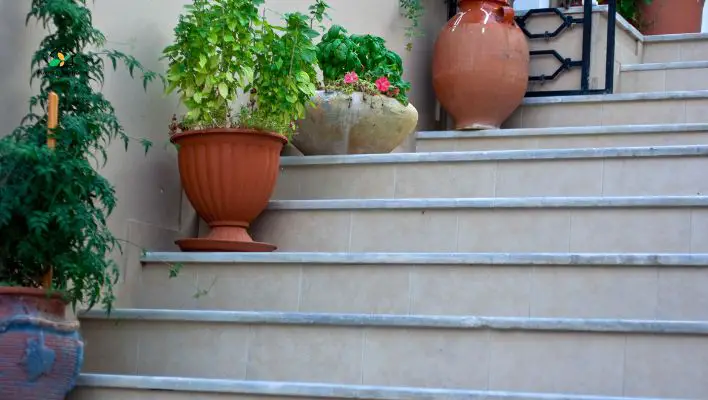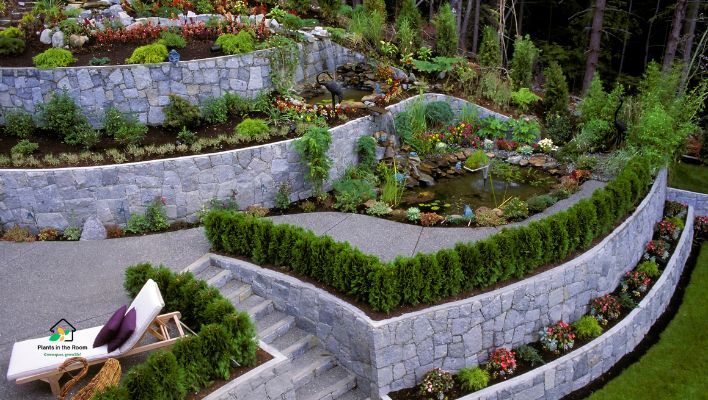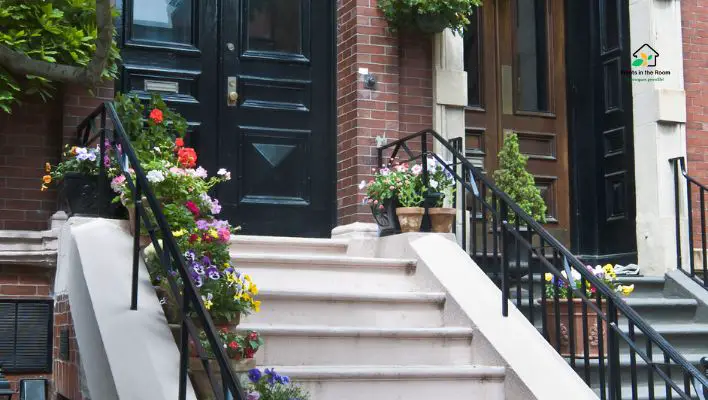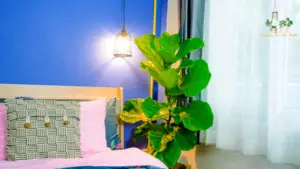This article covers the following areas –
- 7 Reasons to Do Staircase Gardening
- Step 1: Selecting the Right Plants for Your Staircase
- Step 2: Choosing the Right Planters and Pots for Staircase Plants
- Step 3: Arranging the Plants on Your Staircase
- Step 4: Maintaining Your Staircase Garden
- Step 5: Experiment and Enjoy Your Staircase Gardening
- In Conclusion
Are you looking to spruce up your home staircase with a touch of nature? Plants not only add a splash of color and life to an often-overlooked area like a staircase, but they can also improve air quality and boost your mood.
Therefore, in this post, I’ll provide you with a step-by-step process to create your own plant-filled oasis in a casual and engaging manner.
Decorate your staircase with plants by selecting suitable species, choosing the right planters, planning the arrangement, maintaining your garden, and experimenting with different styles to create a personalized staircase garden.
Now, I’ll share my tips and tricks for transforming your staircase into a lush, green paradise. Let’s start with the reasons why you should consider decorating your staircase with different indoor plants. So, let’s get started.
7 Reasons to Do Staircase Gardening
Greenifying your staircase can bring numerous benefits to your home and well-being. Here are some compelling reasons why you should consider adding plants to your staircase.
- Plants can instantly elevate the appearance of your staircase, turning a typically mundane space into a more visually appealing and inviting area. The addition of greenery adds texture, color, and a sense of warmth to your home.
- Plants are natural air purifiers. They absorb carbon dioxide and release oxygen, helping to improve the air quality in your home. Some plants, like the Snake Plant and Peace Lily, can even remove harmful toxins from the air, providing a healthier living environment.
- Studies have shown that being around plants can improve your mood and reduce stress levels. Incorporating plants into your staircase, an area you pass through daily can provide a consistent source of positive energy and relaxation.
- Biophilic design is the concept of incorporating natural elements, such as plants, into the built environment to improve overall well-being. Adding plants to your staircase embraces this design philosophy, fostering a stronger connection to nature within your home.
- Green spaces have been linked to increased creativity and cognitive function. By greenifying your staircase, you create a space that can stimulate your mind and inspire innovative thinking.
- Plants can create a sense of depth and dimension in your staircase, making it appear more spacious and dynamic. Arranging plants with varying heights and textures can further enhance this effect.
- Greenifying your staircase allows you to express your personality and style through the choice of plants, pots, and arrangements. This personal touch can make your home feel more unique and comforting.
In summary, greenifying your staircase can bring aesthetic, health, and emotional benefits, making it a worthwhile home improvement project. By incorporating plants into your staircase, you create a more vibrant, inviting, and healthy living space that can boost your mood and enhance your overall well-being.
Now, let’s dive into the 5 steps of decorating your staircase with plants. I’ll walk you through the entire process, from selecting the right plants to arranging them in the most visually appealing way.
Step 1: Selecting the Right Plants for Your Staircase

The first step in decorating your staircase with plants is to choose the right ones for the job. Keep in mind the amount of sunlight your staircase receives, as this will be crucial in determining which plants will thrive in this space.
If your staircase is well-lit with natural light, you’ll have a wider range of plants to choose from. If it’s a darker area, focus on plants that can tolerate low-light conditions. Here are some suggestions to guide you in making the best choices for your staircase garden.
Assess Your Staircase’s Light Conditions
Observe the amount of sunlight your staircase receives throughout the day. The light conditions will determine which plants are suitable for your space. Consider whether your staircase has bright, indirect light, moderate light, or low light.
Once you’ve determined the light conditions of your staircase, select plants that will thrive in that environment. Here are some suggestions for various lighting conditions:
Bright, indirect light: Pothos, Monstera, Rubber Plant, Snake Plant, Boston Fern
Moderate light: Peace Lily, ZZ Plant, Spider Plant, Dracaena
Low light: Cast Iron Plant, Heartleaf Philodendron, Chinese Evergreen
Think about the Humidity and Temperature of Your Staircase
The humidity and temperature of your staircase are important when selecting plants for your indoor garden. Different plants have unique preferences and tolerances, so choose ones that can thrive in your staircase’s climate.
First, assess the humidity in your staircase area. Some plants, like ferns, need high humidity, while others, like cacti and succulents, prefer drier conditions. Use additional measures, such as misting or water trays, if needed.
Next, consider temperature fluctuations in your staircase. Most houseplants like stable, moderate temperatures, but some can handle more extremes. Be aware of drafts and temperature changes from doors, vents, or seasons.
Consider the Size and Growth Habits of the Staircase Plants
Considering the size and growth habits of staircase plants is crucial in creating a harmonious and functional display. When selecting plants, keep in mind their mature size, as some plants may grow significantly larger than their initial size at purchase.
To keep your staircase clear and safe, select plants that won’t outgrow their space . Place sprawling or trailing plants like Pothos or String of Pearls strategically to avoid tripping hazards.
Combining plants with different heights, shapes, and textures creates a visually appealing staircase display. Use tall plants like Snake Plants for height and depth, and shorter, bushy plants like Spider Plants to fill lower spaces and add lushness.
Evaluate Maintenance Requirements of the Staircase Plants
When selecting plants for your staircase, it’s crucial to choose ones that match your lifestyle and the time you can realistically commit to plant care. Different plants have varying maintenance requirements, so consider the following factors when making your decision:
- Watering
- Pruning
- Fertilizing
- Pest control
- Light requirements
- Re-potting
By evaluating these factors, you can choose staircase plants that suit your lifestyle and available time, ensuring you can provide them with the necessary care and attention for a thriving indoor garden.
Step 2: Choosing the Right Planters and Pots for Staircase Plants

Once you’ve selected your plants, it’s time to pick out the perfect planters and pots to complement your staircase. There are countless options available, from simple terracotta pots to more elaborate hanging planters.
Take your time browsing through different styles and materials to find the ones that best suit your aesthetic and the needs of your plants. Consider the following when choosing planters and pots:
- Style and Material
- Durability
- Drainage
- Size
- Color and Texture
By carefully selecting planters and pots that meet the needs of your plants and complement your staircase’s aesthetic, you can create a visually appealing and functional display that showcases your greenery and enhances your home’s overall atmosphere.
Step 3: Arranging the Plants on Your Staircase

Now comes the fun part: arranging your plants on your staircase. This is where you get to unleash your creativity and create a unique display that’s both visually appealing and functional.
Here are some tips for arranging your plants:
- Mix and match different plant sizes, shapes, and textures to create visual interest. Place taller plants towards the back, and shorter plants in the front to create a sense of depth.
- Repeating elements, such as using similar pots or plants, can create a sense of cohesion and harmony.
- Ensure your plants don’t obstruct the walking path or pose a tripping hazard. Leave enough space for people to move up and down the stairs comfortably.
Step 4: Maintaining Your Staircase Garden

Once you’ve arranged your plants to your satisfaction, it’s crucial to maintain them properly. This will ensure that your staircase garden remains healthy, vibrant, and visually appealing. Here are some essential tips for maintaining your plants:
A) Watering
Understand the specific watering needs of each plant species in your staircase garden. Some may require more frequent watering, while others can withstand longer periods of dryness. Always check the soil moisture before watering to avoid overwatering, which can lead to root rot.
Remember that plants in smaller pots may need more frequent watering. Additionally, be mindful of seasonal changes that might affect your plants’ water requirements.
B) Fertilizing
Fertilize your plants based on their individual nutrient requirements. Many houseplants benefit from a balanced, water-soluble fertilizer applied every few months, while others may require specialized formulations or a different frequency.
Always follow the instructions on the fertilizer package to avoid overfeeding or burning your plants. During the winter months, when growth slows, reduce the frequency of fertilizing or use a milder solution.
C) Pruning and Trimming
Regular pruning and trimming promote healthy growth, maintain your plants’ desired shape, and prevent them from becoming too large for their space. Remove any dead, yellowing, or damaged leaves to keep your plants looking their best. Some plants may also benefit from pinching back new growth to encourage bushier development.
D) Dusting
Dust and dirt can accumulate on your plants’ leaves, reducing their ability to photosynthesize efficiently. Regularly clean your plants’ leaves by gently wiping them with a damp cloth, a soft brush, or even a handheld vacuum with a brush attachment.
Be gentle to avoid damaging the leaves, and always use a clean cloth or brush to prevent the spread of pests or diseases.
E) Monitoring for Pests
Inspect your plants regularly for signs of pests or diseases, such as small insects, discolored leaves, or unusual growth patterns. If you notice any issues, treat the problem promptly to prevent it from spreading to other plants in your staircase garden.
Use insecticidal soap, neem oil, or other recommended treatments based on the specific pest or disease affecting your plant. In some cases, isolating the affected plant from the others may be necessary to prevent the spread of the problem.
Re-potting and Root Maintenance
As your plants grow, they may outgrow their current pots, which can lead to root-bound conditions and reduced growth. Monitor your plants for signs of overcrowding, such as roots growing out of drainage holes or tightly circling the root ball. Re-pot your plants into larger containers as needed, using fresh, well-draining soil to support their continued growth and overall health.
By following these maintenance tips, you can create a thriving staircase garden that remains visually appealing and healthy for years to come. If you want to learn about taking care of any specific plant, read my posts on Plant Care.
Step 5: Experiment and Enjoy Your Staircase Gardening

Embrace the creative process of designing and maintaining your staircase garden by experimenting with various plant arrangements, combinations, and styles. Discovering the perfect balance and aesthetic for your space might involve trial and error, but the journey can be just as enjoyable as the destination. Here are some ideas to inspire your creativity:
- Play with color: Incorporate plants with colorful foliage, flowers, or even fruits to add visual interest and variety to your staircase garden. Experiment with contrasting colors or create a monochromatic theme for a striking effect.
- Add visual interest with texture: Combine plants with different leaf shapes, sizes, and textures to create a rich tapestry of greenery. Pair plants with glossy leaves alongside those with matte or velvety foliage for a diverse, multi-layered look.
- Vary pot styles and materials: Experiment with different planter and pot styles, materials, and colors to complement your plants and staircase design. Mix and match traditional terracotta pots with modern ceramic or metal planters to create an eclectic and personalized display.
- Create focal points: Designate certain areas of your staircase for eye-catching focal points, such as a large, statement plant or a group of smaller plants with unique features. This can guide the viewer’s eye through the space and add depth to your arrangement.
- Rotate and rearrange: Regularly rotate your plants to ensure they receive even light exposure and maintain a balanced growth pattern. You can also periodically rearrange your plants to refresh your staircase garden’s appearance and discover new, visually appealing combinations.
- Don’t forget about scent: Incorporate fragrant plants, such as jasmine or gardenias, to add an extra sensory dimension to your staircase garden. The pleasant aroma will enhance the overall ambiance of your space.
Ultimately, the key to a successful staircase garden is to enjoy the process, embrace your creativity, and create a space that reflects your personality and style. Don’t be afraid to experiment, learn from your experiences, and grow alongside your plants.
In Conclusion
Decorating your staircase with plants can add a refreshing, lively touch to your home. By selecting the right plants, choosing attractive and functional pots, and arranging them in a visually pleasing way, you can create a beautiful, green space that brightens your daily routine.
Remember to maintain your plants properly and enjoy the process of experimenting with different arrangements. With a bit of creativity and care, your staircase can become a stunning, plant-filled oasis.






